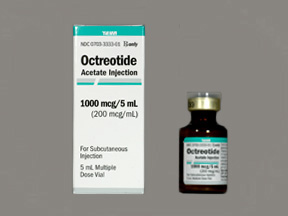
Octreotide is an octapeptide that mimics natural somatostatin pharmacologically, though it is a more potent inhibitor of growth hormone, glucagon, and insulin More
Octreotide is an octapeptide that mimics natural somatostatin pharmacologically, though it is a more potent inhibitor of growth hormone, glucagon, and insulin
Octreotide-It is a long-acting octapeptide with pharmacologic properties mimicking those of the natural hormone somatostatin.
Octreotide; Octreotidum [Latin]; Octreotide-LAR; Octreotide Acetate Salt, Octreotida [Spanish]
Actide, Octate, Ferotide, Octide, Octreo,Octotide, Octride, Okeron, Octronis, Otide, Sandostatin Lar, Sandostatin
(4R,7S,10S,13R,16S,19R)-19-[(2R)-2-amino-3-phenylpropanamido]-10-(4-aminobutyl)-16-benzyl-N-[(2R,3R)-1,3-dihydroxybutan-2-yl]-7-[(1R)-1-hydroxyethyl]-13-[(1H-indol-3-yl)methyl]-6,9,12,15,18-pentaoxo-1,2-dithia-5,8,11,14,17
Octreotide binds to somatostatin receptors. Octreotide binding to these receptors stimulates phosphotyrosine phosphatase and activation of the Na(+)/H(+) exchanger via pertussis toxin insensitive G proteins and coupled via pertussis toxin sensitive G proteins which lead to inhibition of adenylyl cyclase.
The recommended dose is 50-100 mcg twice a day as SC route, dose may increase up to 500 mcg.
For treatment of acromegaly and reduction of side effects from cancer chemotherapy
Local pain, stinging, tingling at site of inj; anorexia, nausea, vomiting, abdominal pain, bloating, flatulence, loose stools, steatorrhoea; biliary tract abnormalities. Hypoglycaemia and hyperglycaemia, hypothyroidism, cardiac conduction abnormalitles, pancreatitis.
Stable at room temperature for up to 14 days. Store at 2-8°C.
1019.25
C49H66N10O10S2
83150-76-9